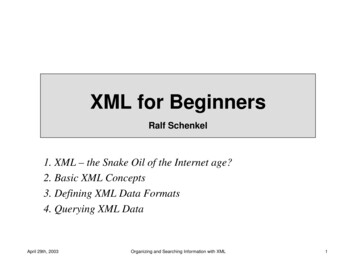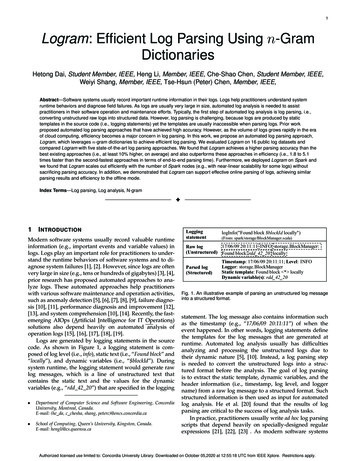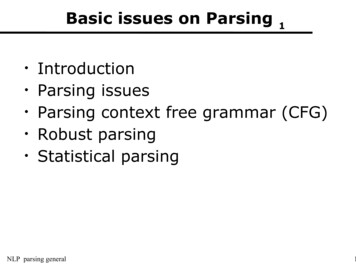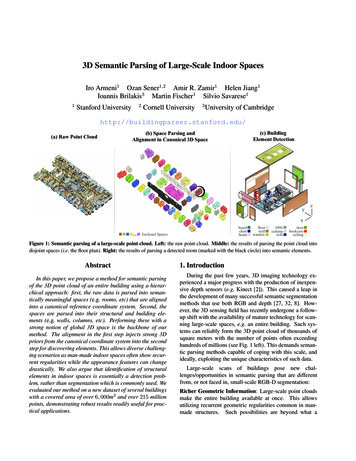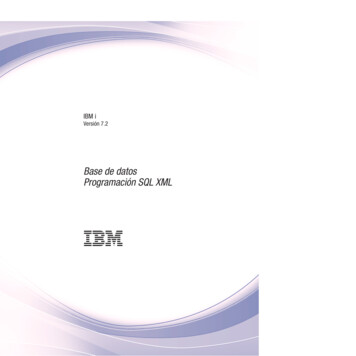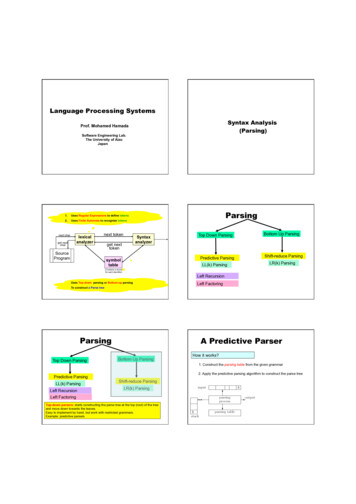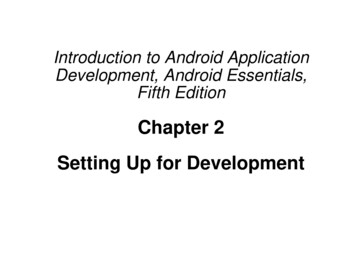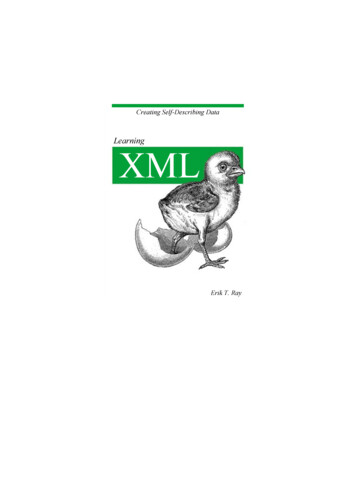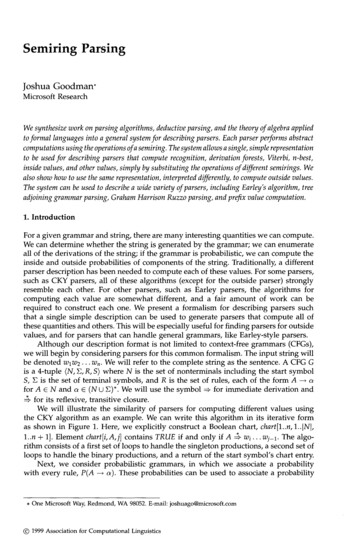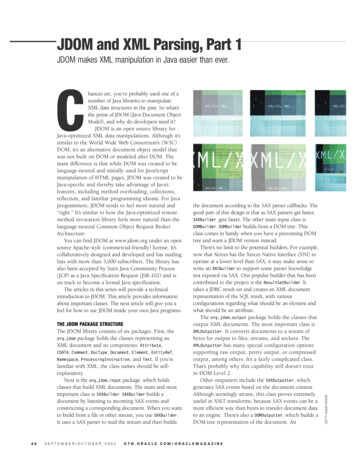
Transcription
JDOM and XML Parsing, Part 1JDOM makes XML manipulation in Java easier than ever.THE JDOM PACKAGE STRUCTUREThe JDOM library consists of six packages. First, theorg.jdom package holds the classes representing anXML document and its components: Attribute,CDATA, Comment, DocType, Document, Element, EntityRef,Namespace, ProcessingInstruction, and Text. If you’refamiliar with XML, the class names should be selfexplanatory.Next is the org.jdom.input package. which holdsclasses that build XML documents. The main and mostimportant class is SAXBuilder. SAXBuilder builds adocument by listening to incoming SAX events andconstructing a corresponding document. When you wantto build from a file or other stream, you use SAXBuilder.It uses a SAX parser to read the stream and then builds68SEPTEMBER/OCTOBER 2002the document according to the SAX parser callbacks. Thegood part of this design is that as SAX parsers get faster,SAXBuilder gets faster. The other main input class isDOMBuilder. DOMBuilder builds from a DOM tree. Thisclass comes in handy when you have a preexisting DOMtree and want a JDOM version instead.There’s no limit to the potential builders. For example,now that Xerces has the Xerces Native Interface (XNI) tooperate at a lower level than SAX, it may make sense towrite an XNIBuilder to support some parser knowledgenot exposed via SAX. One popular builder that has beencontributed to the project is the ResultSetBuilder. Ittakes a JDBC result set and creates an XML documentrepresentation of the SQL result, with variousconfigurations regarding what should be an element andwhat should be an attribute.The org.jdom.output package holds the classes thatoutput XML documents. The most important class isXMLOutputter. It converts documents to a stream ofbytes for output to files, streams, and sockets. TheXMLOutputter has many special configuration optionssupporting raw output, pretty output, or compressedoutput, among others. It’s a fairly complicated class.That’s probably why this capability still doesn’t existin DOM Level 2.Other outputters include the SAXOutputter, whichgenerates SAX events based on the document content.Although seemingly arcane, this class proves extremelyuseful in XSLT transforms, because SAX events can be amore efficient way than bytes to transfer document datato an engine. There’s also a DOMOutputter, which builds aDOM tree representation of the document. AnOTN.ORACLE.COM/ORACLEMAGAZINEGETTY ONE/EYEWIREChances are, you’ve probably used one of anumber of Java libraries to manipulateXML data structures in the past. So what’sthe point of JDOM (Java Document ObjectModel), and why do developers need it?JDOM is an open source library forJava-optimized XML data manipulations. Although it’ssimilar to the World Wide Web Consortium’s (W3C)DOM, it’s an alternative document object model thatwas not built on DOM or modeled after DOM. Themain difference is that while DOM was created to belanguage-neutral and initially used for JavaScriptmanipulation of HTML pages, JDOM was created to beJava-specific and thereby take advantage of Java’sfeatures, including method overloading, collections,reflection, and familiar programming idioms. For Javaprogrammers, JDOM tends to feel more natural and“right.” It’s similar to how the Java-optimized remotemethod invocation library feels more natural than thelanguage-neutral Common Object Request BrokerArchitecture.You can find JDOM at www.jdom.org under an opensource Apache-style (commercial-friendly) license. It’scollaboratively designed and developed and has mailinglists with more than 3,000 subscribers. The library hasalso been accepted by Sun’s Java Community Process(JCP) as a Java Specification Request (JSR-102) and ison track to become a formal Java specification.The articles in this series will provide a technicalintroduction to JDOM. This article provides informationabout important classes. The next article will give you afeel for how to use JDOM inside your own Java programs.
J D O M A N D X M L PA R S I N GBY JASON HUNTERCREATING A DOCUMENTDocuments are represented by the org.jdom.Document class.You can construct a document from scratch:If you’re a power user, you may prefer to use “methodchaining,” in which multiple methods are called insequence. This works because the set methods return theobject on which they acted. Here’s how that looks:Document doc new Document(new Element("root").setText("This is the root"));For a little comparison, here’s how you’d create thesame document, using JAXP/DOM:// JAXP/DOMDocumentBuilderFactory factory er builder factory.newDocumentBuilder();DEVELOPERDocument doc builder.newDocument();Element root doc.createElement("root");Text text doc.createText("This is the );BUILDING WITH SAXBUILDERAs shown earlier, SAXBuilder presents a simple mechanismfor building documents from any byte-oriented resource.The default no-argument SAXBuilder() constructor usesJAXP behind the scenes to select a SAX parser. If you wantto change parsers, you can set the javax.xml.parsers.SAXParserFactory system property to point at the SAXParserFactory implementation provided by your parser. For theOracle9i Release 2 XML parser, you would do this:ORACLEinteresting contributed outputter is the JTreeOutputter,which—with just a few dozen lines of code—builds aJTree representation of the document. Combine thatwith the ResultSetBuilder, and you can go from a SQLquery to a tree view of the result with just a couple oflines of code, thanks to JDOM.Note that, unlike in DOM, documents are not tiedto their builder. This produces an elegant model inwhich you have classes to hold data, various classes toconstruct data, and various other classes to consumethe data. Mix and match as desired!The org.jdom.transform and org.jdom.xpath packageshave classes that support built-in XSLT transformationsand XPath lookups.Finally, the org.jdom.adapters package holds classesthat assist the library in DOM interactions. Users of thelibrary never need to call upon the classes in this package.They’re there because each DOM implementation hasdifferent method names for certain bootstrapping tasks, sothe adapter classes translate standard calls into parserspecific calls. The Java API for XML Processing (JAXP)provides another approach to this problem and actuallyreduces the need for these classes, but they’ve retainedthem because not all parsers support JAXP, nor is JAXPinstalled everywhere, due to license issues.// This builds: root/ Document doc new Document(new Element("root"));java Djavax.xml.parsers.SAXParserFactory oracle.xml.jaxp.JXSAXParserOr you can builkd a document from a file, stream,system ID, or URL:Factory YourAppFor the Xerces parser, you would do this instead:// This builds a document of whatever's in the given resourceSAXBuilder builder new SAXBuilder();java -Djavax.xml.parsers.SAXParserFactory org.apache.xerces.jaxp.Document doc builder.build(url);SAXParserFactoryImpl YourAppPutting together a few calls makes it easy to create asimple document in JDOM:If JAXP isn’t installed, SAXBuilder defaults to ApacheXerces. Once you’ve created a SAXBuilder instance, you canset several properties on the builder, including:// This builds: root This is the root /root Document doc new Document();setValidation(boolean validate)Element e new Element("root");e.setText("This is the root");doc.addContent(e);This method tells the parser whether to validate againsta Document Type Definition (DTD) during the build. It’sORACLE MAGAZINESEPTEMBER/OCTOBER 200269
J D O M A N D X M L PA R S I N Gfalse (off) by default. The DTD used is the one referencedwithin the document’s DocType. It isn’t possible to validateagainst any other DTD, because no parsers support thatcapability yet.setIgnoringElementContentWhitespace(boolean ignoring)This method tells the parser whether to ignore what’scalled ignorable whitespace in element content. Per the XML1.0 spec, whitespace in element content must be preserved bythe parser, but when validating against a DTD it’s possible forthe parser to know that certain parts of a document don’tdeclare to support whitespace, so any whitespace in that areais “ignorable.” It’s false (off) by default. It’s generally good toturn this on for a little performance savings, unless you wantto “round trip” a document and output the same content aswas input. Note that this flag has an effect only if validation ison, and validation causes a performance slowdown, so thistrick is useful only when validation is already in use.// Raw outputXMLOutputter outp new XMLOutputter();outp.output(doc, fileStream);If you don’t care about whitespace, you can enabletrimming of text blocks and save a little bandwidth:// Compressed outputoutp.setTextTrim(true);outp.output(doc, socketStream);If you’d like the document pretty-printed for human display,you can add some indent whitespace and turn on new tp.setNewlines(true);outp.output(doc, System.out);When pretty-printing a document that already has formattingwhitespace, be sure to enable trimming. Otherwise, you’ll addformatting on top of formatting and make something ugly.setFeature(String name, String value)This method sets a feature on the underlying SAX parser.This is a raw pass-through call, so be very careful when usingthis method, because setting the wrong feature (such as tweaking namespaces) could break JDOM behavior. Furthermore,relying on any parser-specific features could limit portability.This call is most useful for enabling schema validation.NAVIGATING THE ELEMENT TREEJDOM makes navigating the element tree quite easy. To get theroot element, call:Element root doc.getRootElement();To get a list of all its child elements:setProperty(String name, Object value)This method sets a property on the underlying SAX parser.It’s also a raw pass-through call, with the same risks and thesame usefulness to power users, especially for schema validation.Putting together the methods, the following code uses theJAXP-selected parser to read a local file, with validationturned on and ignorable whitespace ignored.List allChildren root.getChildren();To get just the elements with a given name:List namedChildren root.getChildren("name");And to get just the first element with a given name:SAXBuilder builder new SAXBuilder();Element child Document doc builder.build(new File("/tmp/foo.xml"));WRITING WITH XMLOUTPUTTERA document can be output to many different formats, butthe most common is a stream of bytes. In JDOM, theXMLOutputter class provides this capability. Its defaultno-argument constructor attempts to faithfully output adocument exactly asWEB LOCATORstored in memory.Open source JDOM libraryThe following codewww.jdom.orgproduces a rawJava Servlet Programming by Jason Hunter (O’Reilly& Associates, 2001)representation of awww.oreilly.comdocument to a file.70SEPTEMBER/OCTOBER 2002The “List” returned by the getChildren() call is ajava.util.List, an implementation of the List interface all Javaprogrammers know. What’s interesting about the List is thatit’s live. Any changes to the list are immediately reflected inthe backing document.// Remove the fourth childallChildren.remove(3);// Remove children named jack"));// Add a new child, at the tail or at the headallChildren.add(new Element("jane"));allChildren.add(0, new Element("jill"));OTN.ORACLE.COM/ORACLEMAGAZINE
J D O M A N D X M L PA R S I N GORACLE XML TOOLShe XML Developer Kit (XDK) is a free library of XML toolsOracle provides for developers. It includes an XML parserand an XSLT transformation engine that can be used withJDOM. You can find lots of information about these tools at theOracle XML home page, oracle.com/xml.To download the parser, look for the XML Developer Kit withthe name “XDK for Java.” Click on “Software” in the left columnfor the download links. Once you unpack the distribution, thefile xmlparserv2.jar contains the parser.To configure JDOM and other software to use the Oracleparser by default, you need to set the JAXP javax.xml.parsers.SAXParserFactory system property to oracle.xml.jaxp.JXSAXParserFactory. This tells JAXP that you prefer the Oracle parser.The easiest way is at the command line:Tjava Djavax.xml.parsers.SAXParserFactory oracle.xml.jaxp.JXSAXParserFactoryWith DOM, moving elements is not as easy, because in DOMelements are tied to their build tool. Thus a DOM element mustbe “imported” when moving between documents.With JDOM the only thing you need to remember is toremove an element before adding it somewhere else, so thatyou don’t create loops in the tree. There’s a detach() methodthat makes the detach/add a one-liner:parent3.addContent(movable.detach());If you forget to detach an element before adding it to anotherparent, the library will throw an exception (with a truly preciseand helpful error message). The library also checks Elementnames and content to make sure they don’t include inappropriate characters such as spaces. It also verifies other rules, suchas having only one root element, consistent namespacedeclarations, lack of forbidden character sequences in commentsand CDATA sections, and so on. This feature pushes “wellformedness” error checking as early in the process as possible.HANDLING ELEMENT ATTRIBUTESElement attributes look like this:You can also set this rFactory");In addition to XDK, Oracle provides a native XML repository withOracle9i Database Release 2. Oracle9i XML Database (XDB) is ahigh-performance, native XML storage and retrieval technology. Itfully absorbs the W3C XML data model into Oracle9i Database andprovides new standard access methods for navigating and querying XML. With XDB, you get all the advantages of relational database technology plus the advantages of XML technology. table width "100%" border "0" . /table With a reference to an element, you can ask the element forany named attribute value:String val table.getAttributeValue("width");You can also get the attribute as an object, for performingspecial manipulations such as type conversions:Attribute border table.getAttribute("border");int size border.getIntValue();Using the List metaphor makes possible many elementmanipulations without adding a plethora of methods.For convenience, however, the common tasks of addingelements at the end or removing named elements havemethods on Element itself and don’t require obtainingthe List first:To set or change an attribute, use setAttribute():table.setAttribute("vspace", "0");To remove an attribute, use root.removeChildren("jill");WORKING WITH ELEMENT TEXT CONTENTroot.addContent(new Element("jenny"));An element with text content looks like this:One nice perk with JDOM is how easy it can be to moveelements within a document or between documents. It’s thesame code in both cases: description A cool demo /description Element movable new Element("movable");parent1.addContent(movable);// placeIn JDOM, the text is directly available by calling:parent1.removeContent(movable); // removeparent2.addContent(movable);72// addSEPTEMBER/OCTOBER 2002String desc E
If you really want whitespace out of the picture, there’s even agetTextNormalize() method that normalizes internal whitespace !-- Some comment -- Some text tr Some child element /tr /table When an element contains both text and child elements,it’s said to contain “mixed content.” Handling mixed contentcan be potentially difficult, but JDOM makes it easy. Thestandard-use cases—retrieving text content and navigatingchild elements—are kept simple:with a single space. It’s handy for text content like this: description String text table.getTextTrim();// "Some text"Element tr table.getChild("tr");// A straight referenceSometimes you have text content with formattingspace within the string. /description For more advanced uses needing the comment, whitespaceblocks, processing instructions, and entity references, the rawmixed content is available as a List:To change text content, there’s a setText() method:List mixedCo table.getContent();description.setText("A new description");Iterator itr mixedCo.iterator();while (itr.hasNext()) {Any special characters within the text will be interpretedcorrectly as a character and escaped on output as needed tomaintain the appropriate semantics. Let’s say you make this call:Object o i.next();if (o instanceof Comment) {.}element.setText(" xml/ content");// Types include Comment, Element, CDATA, DocType,// ProcessingInstruction, EntityRef, and TextThe internal store will keep that literal string as characters.There will be no implicit parsing of the content. On output,you’ll see this:}As with child element lists, changes to the raw content listaffect the backing document: elt <xml/> content elt // Remove the Comment.This behavior preserves the semantic meaning of theearlier setText() call. If you want XML content held withinan element, you must add the appropriate JDOM childelement objects.Handling CDATA sections is also possible within JDOM. ACDATA section indicates a block of text that shouldn’t beparsed. It is essentially a “syntactic sugar” that allows the easyinclusion of HTML or XML content without so many < and> escapes. To build a CDATA section, just wrap the stringwith a CDATA object:element.addContent(new CDATA(" xml/ content"));What’s terrific about JDOM is that a getText() call returnsthe string of characters without bothering the caller withwhether or not it’s represented by a CDATA section.DEALING WITH MIXED CONTENTSome elements contain many things such as whitespace,comments, text, child elements, and more:It's "1" because "0" is a whitespace block.mixedCo.remove(1);If you have sharp eyes, you’ll notice that there’s a Text classhere. Internally, JDOM uses a Text class to store string contentin order to allow the string to have parentage and more easilysupport XPath access. As a programmer, you don’t need toworry about the class when retrieving or setting text—onlywhen accessing the raw content list.For details on the DocType, ProcessingInstruction, andEntityRef classes, see the API documentation at www.jdom.org.COMING IN PART 2In this article we began examining how to use JDOM in yourapplications. In the next article, I examine XML Namespaces,ResultSetBuilder, XSLT, and XPath. You can find Part 2 of thisseries online now at otn.oracle.com/oraclemagazine. Jason Hunter (jasonhunter@servlets.com) is a consultant, publisher ofServlets.com, and vice president of the Apache Software Foundation. He holds aseat on the JCP Executive Committee.ORACLE MAGAZINESEPTEMBER/OCTOBER 200273DEVELOPERString betterDesc description.getTextTrim(); table ORACLEJust remember, because the XML 1.0 specification requireswhitespace to be preserved, this returns "\n A cool demo\n".Of course, as a practical programmer you often don’t needwant to be so literal about formatting whitespace, so there’s aconvenient method for retrieving the text while ignoringsurrounding whitespace:
JDOM makes XML manipulation in Java easier than ever. hances are, you've probably used one of a number of Java libraries to manipulate XML data structures in the past. So what's the point of JDOM (Java Document Object Model), and why do developers need it? JDOM is an open source library for Java-optimized XML data manipulations. Although it's
